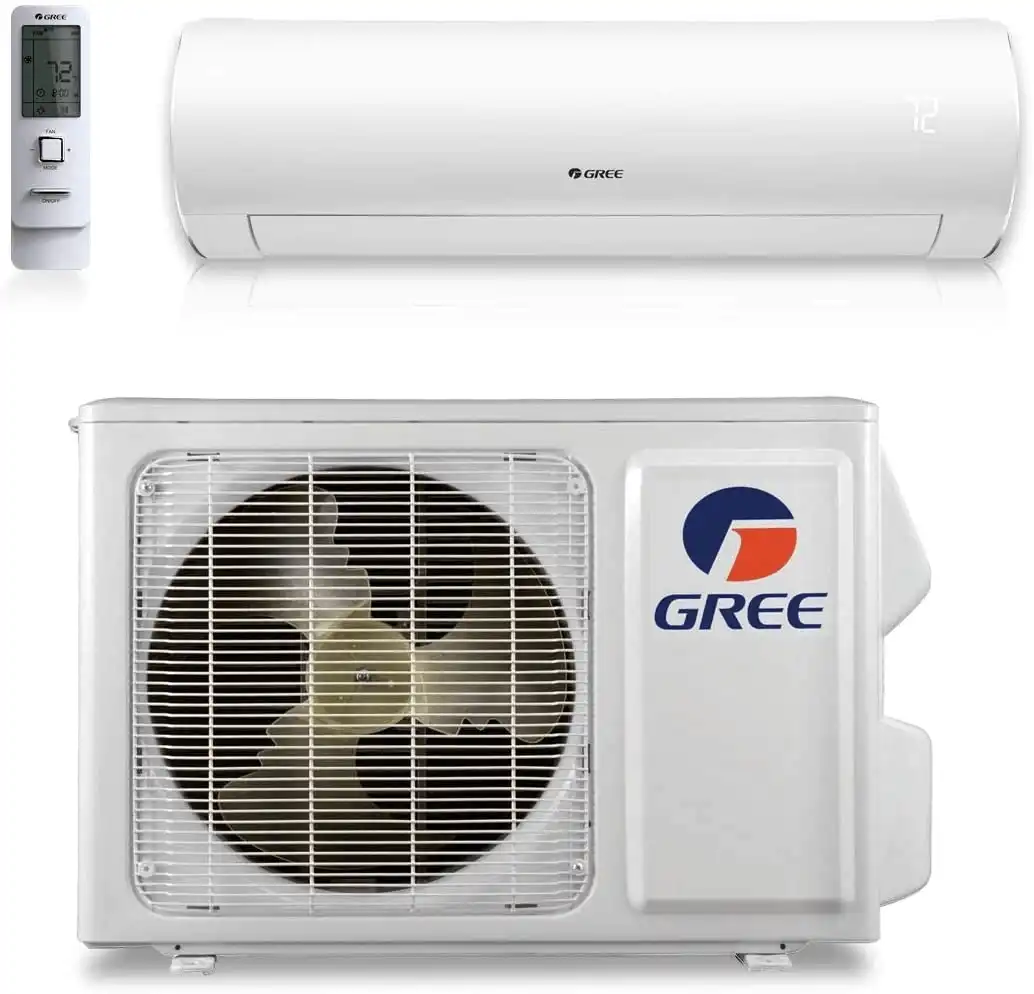
5 Mini-Split Installation Mistakes to Avoid
For HVAC contractors and homeowners looking to understand the process, a correct mini-split system installation is critical to achieving optimal performance, energy efficiency, and long-term reliability. A poorly executed installation can lead to costly repairs, reduced efficiency, and even safety hazards. Whether you're a seasoned technician or a homeowner learning what professional installation entails, understanding common mistakes helps ensure reliable results.
This guide breaks down five of the most frequent errors made during mini-split installations, from improper unit placement to electrical mishaps, and provides clear steps to prevent them. By following these best practices, you'll not only extend the lifespan of the system but also ensure it operates as designed, delivering the comfort and efficiency mini-splits are known for. Let's dive in and explore how to get it right the first time.
Wrong Placement of Indoor and Outdoor Units
Choosing the right spots for indoor and outdoor units during a mini-split installation is crucial. Poor placement can hurt system efficiency, create uneven temperatures, and reduce the lifespan of the equipment. Both units need to be positioned thoughtfully to optimize airflow, heat exchange, and overall performance.
Prioritizing convenience over long-term functionality can lead to frequent service calls and unsatisfied customers. A well-thought-out placement ensures smoother operation and durability.
Common Placement Errors
Indoor unit placement mistakes often involve improper height and airflow issues. Mounting the unit too high can limit air circulation, while positioning it too low can result in drafts and insufficient coverage. Installing units directly above furniture, beds, or workspaces without considering airflow patterns can also reduce comfort levels.
Outdoor units require just as much attention. Although GREE outdoor units such as the Vireo Gen3 and Sapphire are designed for high ambient temperatures, placement in constant direct sunlight can still reduce efficiency. Situating outdoor units too close to walls, fences, or landscaping can block airflow and hinder heat dissipation. Additionally, placing them near heat sources like dryer vents, condensing unit discharges, or exhaust terminations can expose the unit to higher ambient temperatures, further straining its performance. Avoiding these common errors is key to ensuring optimal placement.
Proper Unit Placement Guidelines
Strategic placement of mini-split units boosts efficiency and reliability. Indoor units should ideally be mounted at a height that promotes effective air distribution. Positioning them on interior walls, rather than exterior ones prone to temperature changes, can also improve performance. Ensure there's enough clearance around the unit, as specified by the manufacturer, to allow for unobstructed airflow.
For outdoor units, maintaining adequate clearance on all sides is essential to support proper airflow and prevent hot air from recirculating back into the unit. Always follow the manufacturer's recommendations for clearance distances. In areas prone to flooding or heavy snow, consider elevating the unit on platforms or wall brackets to protect it from water or snow buildup. This also simplifies maintenance.
Providing shade for outdoor units can help improve performance and extend their lifespan. However, ensure that nearby plants or structures don't block airflow. Additionally, plan the refrigerant line path carefully - keeping it as short and direct as possible with minimal elevation changes - to maintain system efficiency.
Lastly, outdoor units should be placed on a stable, level platform that can support the unit's weight while allowing easy access for technicians. Proper placement not only ensures smooth operation but also minimizes the need for future adjustments or repairs.
Faulty Electrical Connections
Electrical integrity is one of the most critical aspects of any GREE mini-split installation. Yet, they're also one of the most common areas where contractors make serious mistakes. Poor wiring doesn't just compromise performance - it creates safety risks, voids warranties, and can lead to system failures. Just as proper unit placement is key, getting the electrical setup right is essential for safe and efficient operation. Following correct procedures and adhering to local codes helps ensure safety and shields both contractors and homeowners from potential liabilities.
Mini-split systems come in different configurations. While single-zone models have simpler electrical needs, multi-zone systems require meticulous attention to details like voltage, amperage, and grounding. Even seasoned contractors can overlook critical steps if they rush through the process.
Common Wiring Mistakes
Several wiring errors can jeopardize the safety and functionality of a mini-split system:
- Voltage mismatches: A common mistake is assuming all units run on 115V. Connecting a 230V unit to a 115V circuit causes underperformance, while plugging a 115V unit into a 230V circuit can result in immediate damage.
- Loose wire connections: Under-tightened terminal screws or poorly secured wire nuts can lead to arcing, overheating, and eventual system failure. These issues often develop slowly, making them harder to spot but potentially hazardous, as they may lead to electrical fires.
- Improper wire gauge: Improper wire gauge selection violates NEC Article 310.15. For most mini-splits, 12 AWG copper conductors are required for 20A circuits unless otherwise specified. Using the wrong wire size can also create fire hazards. This issue is particularly concerning for longer wire runs, where voltage drop becomes a significant factor.
- Grounding problems: Skipping proper grounding or failing to maintain continuity between indoor and outdoor units poses serious safety risks.
- Control wire errors: In multi-zone systems, mistakes in control wire installation - such as using the wrong type, failing to separate them from power conductors, or damaging the wires - can disrupt communication between indoor and outdoor units.
Addressing these problems requires strict adherence to proper wiring procedures.
Correct Wiring Procedures
To avoid the pitfalls outlined above, follow these essential steps:
- Conduct a professional electrical assessment: Before installation, have a licensed electrician evaluate the existing electrical panel to ensure it can handle the added load. This assessment should include checking total system amperage, available breaker space, and overall electrical service capacity.
- Follow manufacturer documentation: Adhering to GREE Comfort installation guides is essential. These resources detail electrical requirements, wire gauges, and circuit protection necessary to maintain warranty coverage.
- Install dedicated circuits: Each outdoor unit should have its own dedicated circuit with the correct amperage rating and circuit protection. This setup prevents interference from other appliances and ensures a steady power supply to the HVAC system.
- Use proper disconnects: Install a disconnect switch near the outdoor unit to provide safety for technicians during maintenance. The disconnect should be visible from the unit, correctly rated for the system's amperage, and installed according to local codes. Many areas also require weatherproof enclosures and specific placement distances.
- Handle control wires carefully: In multi-zone systems, low-voltage control wires should be routed separately from power conductors to avoid interference. Ensure they are secured to prevent damage and connected according to the manufacturer's specifications. Using the wrong wire type or gauge can disrupt system functionality, even if the power connections are correct.
Poor Refrigerant and Line Set Handling
Handling refrigerants and line sets correctly is essential, as mistakes can lead to environmental damage, regulatory violations, and system malfunctions.
Modern mini-split systems often use refrigerants like R-410A and R-32, which require specific tools and handling techniques. These refrigerants operate at higher pressures than older ones, making proper installation practices crucial. Neglecting key steps in refrigerant and line set handling can result in reduced performance and long-term reliability issues. Below, we'll explore common problems and the best ways to address them.
Refrigerant Handling Problems
Refrigerant leaks are a frequent issue, typically caused by poor connection techniques or insufficient pressure testing. These leaks can significantly reduce system efficiency.
Contamination is another concern. Allowing moisture, dirt, or air into the refrigerant system can damage the compressor and shorten its lifespan. This is especially problematic in humid environments, where proper sealing is critical to keep contaminants out.
Failing to follow EPA Section 608-approved recovery procedures can lead to violations of EPA refrigerant handling regulations and void GREE warranty coverage. Certified technicians must use approved recovery equipment and maintain detailed records. If evacuation procedures are not performed correctly, moisture and contaminants can remain in the system, potentially causing acid formation and eventual compressor failure.
Line Set Installation Problems
Issues with line set installation can further harm system performance. Problems like sharp bends, poor support, or inadequate insulation disrupt refrigerant flow and reduce efficiency.
Flare fitting connections are another common trouble spot. Over-tightening can damage the copper tubing, while under-tightening creates potential for leaks. Proper flare connections require adherence to specific torque specifications outlined by the manufacturer.
Insufficient insulation of the line set can result in energy loss and condensation problems. Gaps in insulation, compressed foam, or using unsuitable materials can lead to condensation on suction lines, which may damage nearby building materials.
Improper line sizing or exceeding GREE-approved line set lengths and diameters can restrict refrigerant flow and reduce system performance. Using line sets without verifying manufacturer specifications can restrict refrigerant flow if the liquid line is too small or disrupt compressor oil return if the suction line is too large, upsetting the system's balance.
Correct Refrigerant and Line Set Procedures
To ensure proper refrigerant and line set handling, follow these best practices:
- Use EPA-certified recovery equipment and always work with tools that are in good condition and properly calibrated.
- When cutting tubing, use a tube cutter to create clean, square cuts without metal shavings. Deburr all cuts and keep line ends capped until ready for connection.
- Route line sets carefully to avoid sharp bends and ensure proper support, maintaining optimal refrigerant flow.
- Use a high-quality flaring tool to create consistent, leak-free flare connections. Always follow the manufacturer's torque specifications for these connections.
- During system evacuation and leak testing, achieve and maintain the correct vacuum level to ensure system integrity. Use electronic leak detectors or soap solution testing to confirm all connections are secure before introducing refrigerant.
- Insulate line sets properly to prevent energy loss and condensation. Closed-cell foam insulation of the right thickness should be used, with all joints sealed using insulation tape to eliminate gaps or compressed areas.
Adhering to manufacturer guidelines is critical for maintaining warranty coverage and ensuring optimal system performance. GREE Comfort provides detailed installation documentation covering refrigerant handling, line set installation, and system commissioning, helping contractors avoid common errors while meeting regulatory standards.
System Sizing Mistakes
Getting the size of a mini-split system right is one of the most important parts of installation, yet it's often underestimated or miscalculated. Proper sizing directly affects energy use, comfort, and the lifespan of the equipment. When sizing is off, the system's performance suffers, leading to discomfort and reliability issues over time.
System size is measured in BTU/h (British Thermal Units per hour), with one ton equaling 12,000 BTU/h. But understanding the numbers isn't enough - the real challenge is calculating the specific heating and cooling needs for each unique space. Recognizing the consequences of incorrect sizing can help contractors anticipate and address these challenges effectively.
Problems from Wrong Sizing
An undersized system struggles to meet temperature demands, leaving some areas too warm or too cold. To compensate, the system runs constantly, which overworks the compressor and can lead to early breakdowns. This nonstop operation not only increases wear and tear but also drives up energy bills, as the system uses maximum power without delivering the desired results. Additionally, undersized units often fail to dehumidify properly, leaving spaces feeling damp and uncomfortable. Over time, the increased stress on components can lead to frequent repairs and a shorter service life, often cutting the unit's lifespan significantly.
On the other hand, oversized systems come with their own set of problems. These units heat or cool spaces too quickly, causing short cycling - frequent starts and stops that disrupt the system's efficiency. Even with inverter technology, significantly oversized mini-splits can still experience these issues. Short cycling reduces effective dehumidification, as the system doesn't run long enough to remove enough moisture from the air. This can lead to high indoor humidity, which creates a perfect environment for mold growth. Moreover, the constant starting and stopping puts extra strain on components like the compressor, reducing the system's lifespan and increasing the likelihood of repairs. Despite cooling or heating faster, these frequent cycles actually use more energy, resulting in higher utility costs.
Proper Sizing Methods
Accurate system sizing is just as crucial as proper unit placement and wiring. The best way to ensure correct sizing is through professional load calculations using specialized software. These calculations consider far more than just square footage - they factor in insulation quality, window placement, ceiling height, and even local climate conditions. System sizing should always be based on Manual J or equivalent load calculations, not rule-of-thumb estimates. Contractors can use the GREE System Builder Tool to perform accurate load matching and ensure optimal performance.
For multi-zone systems, sizing becomes even more complex. Each indoor unit must be sized for the room it serves, while the outdoor unit must handle the combined load of the entire home. It's essential that the total capacity of the indoor units matches the operating range of the outdoor condenser to maintain balance and efficiency.
GREE Comfort offers tools and technical support to simplify the sizing process. Their resources are tailored to the performance characteristics of GREE systems, helping ensure installations meet both the capacity needs and efficiency standards required for optimal operation.
Skipping Professional Assessment and Support
Opting out of professional assessment and manufacturer support might seem like a way to cut costs initially, but it often leads to expensive mistakes. Professional expertise ensures the system is installed correctly, complies with local codes, and operates at peak performance. Even seasoned contractors rely on manufacturer resources and technical support to handle the complexities of today's mini-split systems.
Skipping professional guidance can create unsafe conditions, lower efficiency, and void GREE manufacturer warranties, which often result in costly repairs. These risks highlight the importance of expert involvement, as explored in the following sections.
Problems with DIY Installations
DIY installations not only pose safety risks but also void the GREE manufacturer warranty, which requires installation by certified HVAC professionals. Improper wiring, for example, can lead to electrical fires, electrocution, or code violations. Many DIY installers underestimate the challenges of working with high-voltage components, which can result in liability issues if something goes wrong.
Water damage is another common problem. Incorrectly installed condensate drains can cause water to back up, leading to leaks in walls, ceilings, or floors. This can result in mold growth and structural damage. Additionally, poorly connected refrigerant lines may cause leaks, reducing system efficiency and damaging surrounding materials, which often require expensive repairs.
Another major concern is warranty coverage. Most manufacturers, including GREE Comfort, mandate professional installation to maintain warranties. If a DIY-installed system fails, homeowners may face the full cost of repairs that would otherwise be covered. Improper installation techniques can also shorten the system's lifespan by causing premature component failure.
In many cases, these issues necessitate a complete reinstallation by professionals, significantly increasing the overall cost.
Benefits of Manufacturer Support
On the other hand, utilizing manufacturer support reduces these risks and ensures the system operates as intended. GREE Comfort provides detailed documentation and instructional videos that guide proper installation techniques, helping contractors correctly identify components and follow procedures. This is particularly helpful when dealing with advanced features like smart controls or multi-zone configurations.
Direct technical support is another key advantage. GREE Comfort's call center offers live assistance Monday through Friday, from 8:00 AM to 5:00 PM EDT, to address installation questions and urgent issues. Additionally, online tools like FAQs and an error code diagnostic tool allow contractors to quickly resolve problems on-site, minimizing callbacks and boosting customer satisfaction.
Manufacturer support also includes GREE product compatibility charts and documentation, ensuring components are matched correctly and smart features like the GREE WiFi App integrate seamlessly. Compatibility charts and integration guides empower contractors to confidently design and install systems that meet customer needs.
Following GREE's guidelines helps contractors maintain warranty coverage, protecting both themselves and homeowners from unexpected expenses. Warranty parts must be ordered through GREE distributors by certified installers, underscoring the importance of using genuine components to preserve system reliability.
For contractors enrolled in the GREE Select Dealer Program, the benefits go even further. Participants gain access to extended warranties, cash incentives, and lead generation opportunities, rewarding their commitment to professional installation standards and ongoing training.
Conclusion: How to Avoid These 5 Installation Mistakes
Steering clear of these five common errors - poor unit placement, improper electrical connections, mishandling refrigerants, incorrect system sizing, and neglecting professional expertise - can save you from expensive callbacks, reduced system efficiency, and a damaged reputation.
A successful installation starts with thorough preparation. Evaluate the space, check electrical capacity, and perform accurate load calculations before beginning any project. This upfront effort helps avoid costly mistakes and unnecessary rework down the line.
Once your plan is solid, take advantage of GREE's professional tools: System Builder, Training Videos, FAQs, and Documentation.
For additional help, their technical support team is available Monday through Friday, 8:00 AM–5:00 PM EDT.
FAQs
What problems can arise from poor mini-split placement, and how can you avoid them?
Placing a mini-split unit in the wrong spot can lead to uneven heating or cooling, blocked airflow, and short cycling, all of which can hurt energy efficiency and drive up utility bills. Additionally, improper placement can cause unnecessary strain on the system, potentially shortening its lifespan.
To prevent these problems, make sure the unit is installed in a central, open area to allow air to circulate evenly. Avoid placing it near furniture, curtains, or other items that might obstruct airflow. Also, ensure it's mounted on a level surface to avoid operational issues. Choosing the right location is essential for keeping your system running efficiently and extending its life.
What steps should I take to ensure the electrical connections for my mini-split system are safe and meet local codes?
To keep your mini-split system's electrical connections safe and in line with U.S. regulations, always use a dedicated circuit tailored to the system's voltage and amperage needs. Most GREE systems require 208/230V dedicated circuits rated between 15-45A, per NEC Article 440.14, for proper guidelines, and double-check any additional requirements specific to your local area.
A disconnect switch must be installed near the outdoor unit, as outlined in NEC 440.14. Additionally, all wiring should be secured within a conduit or raceway to protect it from damage. Be sure to use high-quality materials that meet NEC standards to guarantee both safety and durability. If you're uncertain about any part of the installation, it's wise to consult a licensed electrician to confirm everything is set up correctly and adheres to all applicable codes.
Why should you get a professional assessment for mini-split installation, and how does manufacturer support help?
Getting a professional evaluation for your mini-split installation plays a key role in making sure the system is the right size, properly placed, and set up for top-notch performance. This step doesn't just improve energy efficiency - it also enhances comfort and can lead to long-term savings on your energy bills.
Relying on manufacturer support offers extra advantages, such as ensuring the installation follows all required standards, protecting your warranty, and boosting the system's longevity and performance. Plus, it provides access to expert advice and detailed documentation tailored to your specific system, making the entire process more seamless and dependable.




